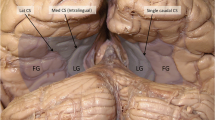Abstract
Surgical accesses to lesions of the posterolateral pontomesencephalic junction (PMJ) region and the posterolateral tentorial gap remain a challenge in the field of neurosurgery. Since the first report of application of the extreme lateral supracerebellar infratentorial (ELSI) approach in resecting the PMJ lesions in 2000, a few articles concerning the ELSI approach have been published. The present review mainly provided an intimate introduction of the ELSI approach, and evaluated it in facets of patient position, skin incision, craniectomy, draining veins, retraction against the cerebellum, exposure limits, patient healing, as well as advantages and limitations compared with other approaches. The ELSI approach is proposed to be a very young and promising approach to access the lesions of posterolateral PMJ region and the posterolateral tentorial gap. Besides, it has several advantages such as having a shorter surgical pathway, causing less surgical complications, laborsaving, etc. Still, more studies are needed to improve this approach.
摘要
神经外科手术中, 后外侧小脑幕切记间隙以及后外侧脑桥中脑结合部是很难到达的区域, 切除这些部位的病变在神经外科领域一直是个很大的挑战。 自从2000年极外侧幕下小脑上入路被首次报道可用于切除后外侧脑桥中脑结合部位的病变以来, 这一新入路为解决神经外科手术难题提供了新的方案。 本文主要从手术体位、 皮肤切口、 骨瓣形成、 入路相关引流静脉的处理、 小脑牵引、 暴露范围及内容、 病人手术效果等方面对该入路进行了全面的综述。 极外侧幕下小脑上入路是在后外侧小脑幕切迹间隙和后外侧脑桥中脑结合部等部位切除病变的可选入路, 相较于其他入路有手术路径短、 手术并发症少、 省力等诸多优点, 值得在临床工作中推广。
Similar content being viewed by others
References
Horsley V. Discussion. Proc R Soc Med. 1910;3.
Yasargil MG. Paramedian supracerebellar approach, in Yasargil MG (ed): Microneurosurgery. New York: George Thieme, 1984: 242.
Matsushima T, Fukui M, Suzuki S, Rhoton AL Jr. The microsurgical anatomy of the infratentorial lateral supracerebellar approach to the trigeminal nerve for Tic Douloureux. Neurosurgery 1989, 24: 890–895.
Vishteh AG, David CA, Marciano FF, Coscarella E, Spetzler RF. Extreme lateral supracerebellar infratentorial approach to the posterolateral mesencephalon: technique and clinical experience. Neurosurgery 2000, 46(2): 384–389.
Ammirati M, Bernardo A, Musumeci A, Bricolo A. Comparison of different infratentorial-supracerebellar approaches to the posterior and middle incisural space: a cadaveric study. J Neurosurg 2002, 97(4): 922–928.
Ammirati M, Musumeci A, Bernardo A, Bricolo A. The microsurgical anatomy of the cisternal segment of the trochlear nerve, as seen through different neurosurgical operative windows. Acta Neurochir 2002, 144: 1323–1327.
Vougioukas VI, Omran H, Gläsker S, Van Velthoven V. Far lateral supracerebellar infratentorial approach for the treatment of upper brainstem gliomas: clinical experience with pediatric patients. Childs Nerv Syst 2005, 21(12): 1037–1041.
Jittapiromsak P, Little A, Deshmukh P, Nakaji P. Comparative analysis of the retrosigmoid and lateral supracerebellar infratentorial approaches along the lateral surface of the pontomesencephalic junction: a different perspective. Neurosurgery 2008, 62: ONS279–287.
De Oliveira JG, Lekovic GP, Safavi-Abbasi S, Reis CV, Hanel RA, Porter RW, et al. Supracerebellar infratentorial approach to cavernous malformations of the brainstem:surgical variants and clinical experience with 45 patients. Neurosurgery 2010, 66: 389–399.
Ono M, Ono M, Rhoton AL Jr, Barry M. Microsurgical anatomy of the region of the tentorial incisura. J Neurosurg 1984, 60: 365–399.
Rhoton AL Jr. Tentorial incisura. Neurosurgery 2000, 47(Suppl 3): S131–S153.
Rhoton AL Jr, Ono M. Microsurgical anatomy of the region of the tentorial incisura, in Wilkins RH, Rengachary SS (eds): Neurosurgery, 2nd ed. New York: McGraw-Hill, 1996: 897–915.
Oppenheim H, Krause F. Operative Erflog bei Geschwülsten der Sehhügel- und Vierhügelgegend. Berl Klin Wochenschr 1913, 50: 2316–2322.
Krause F. Operative Freilegung der Vierhügel, nebst Beobachtungen über Hirndruck und Dekompression. Zentralb Chir 1926, 53: 2812–2819.
Stein BM. The infratentorial supracerebellar approach to pineal lesions. J Neurosurg 1971, 35(2): 197–202.
Hayashi N, Kurimoto M, Nagai S, Sato H, Hori S, Endo S. Tentorial incision in a lateral-medial direction with minimal retraction of the temporal lobe in the subtemporal transtentorial approach to the middle tentorial gap. Minim Invas Neurosurg 2008, 51: 340–344.
Van den Bergh R. Lateral-paramedian infratentorial approach in lateral decubitus for pineal tumours. Clin Neurol Neurosurg 1990, 92(4): 311–316.
Hitotsumatsu T, Matsushima T, Inoue T. Microvascular decompression for treatment of trigeminal neuralgia, hemifacial spasm, and glossopharyngeal neuralgia: Three surgical approach variations: Technical note. Neurosurgery 2003, 53: 1436–1441.
Zhao JZ. A review of minimally invasive neurosurgery in the past 10 years. Zhonghua Yi Xue Za Zhi 2010, 90(13): 865–866.
Author information
Authors and Affiliations
Corresponding author
Rights and permissions
About this article
Cite this article
Chen, X., Feng, YG., Tang, WZ. et al. A young and booming approach: the extreme lateral supracerebellar infratentorial approach. Neurosci. Bull. 26, 479–485 (2010). https://doi.org/10.1007/s12264-010-1036-7
Received:
Accepted:
Published:
Issue Date:
DOI: https://doi.org/10.1007/s12264-010-1036-7




